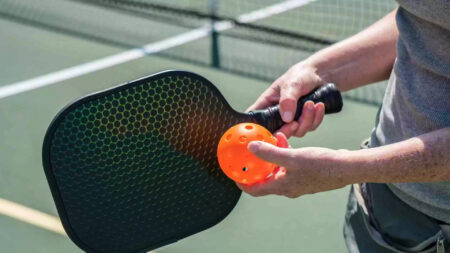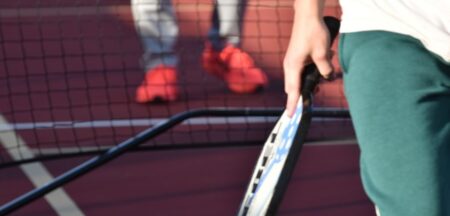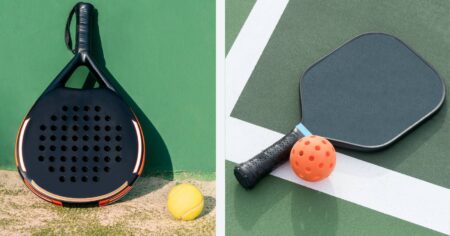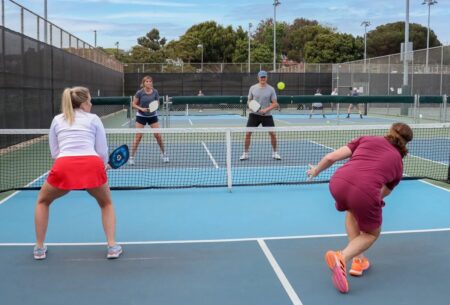
Are you ready to learn about a surprising aspect of pickleball? Well, get ready to have your mind blown because today we’re going to tackle the question: can you bounce serve in pickleball?
It’s a topic that has sparked some intense debates among players, and you might be surprised by the answer. In this article, we will explore the rules of pickleball, the arguments for and against bounce serves, and even delve into the science behind them.
So, if you’ve ever wondered whether it’s legal to bounce serve in pickleball or if it gives players an unfair advantage, then this article is for you.
The Rules of Pickleball
Did you know that in pickleball, you can actually use a bounce serve to catch your opponents off guard and gain an advantage? It may surprise you, but according to the official rules of pickleball, a bounce serve is actually allowed.
The pickleball serve rules state that the serve must be made underhand and the paddle must make contact with the ball below the server’s waist. The serve must be diagonal and land within the confines of the opponent’s service court. These rules apply to both singles and doubles play.
However, there is a gray area when it comes to bounce serves. Some argue that a bounce serve is an illegal serve, as the ball must be hit directly into the air without bouncing it first. On the other hand, proponents of the bounce serve argue that the rules do not explicitly state that the ball cannot bounce before serving. They believe that a bounce serve can be a strategic move to throw off the opponent’s timing and gain an advantage.
The arguments for and against bounce serves revolve around interpretation of the rules. While some players believe that a bounce serve should be considered illegal, others see it as a valid tactic within the game. Ultimately, it is up to the players and the officials to determine whether a bounce serve is allowed or not.
The Arguments For and Against Bounce Serves
Explore the exhilarating debate surrounding the pros and cons of incorporating bounce serves into the game of pickleball. Can you bounce serve in pickleball? This question has sparked heated discussions among players and enthusiasts alike. Let’s dive into the arguments for and against bounce serves in this beloved sport.
- Unpredictability: Bounce serves add an exciting element of surprise to the game. They can catch opponents off guard, forcing them to quickly react and adapt. This element of unpredictability adds an extra layer of excitement to the gameplay.
- Strategic Advantage: Bounce serves can provide players with a strategic advantage. By utilizing different angles and spins, players can strategically place the ball in difficult positions for their opponents to return. This requires skill and precision, making the game more challenging and engaging.
- Enhanced Skill Development: Allowing bounce serves encourages players to improve their serving techniques. It pushes them to develop better control, accuracy, and power in their serves. This not only enhances their serving abilities but also helps them improve their overall gameplay.
On the other hand, there are arguments against bounce serves in pickleball:
- Difficulty for Beginners: Bounce serves can be challenging for beginners to master. It requires a certain level of skill and experience to execute bounce serves effectively. This may discourage newcomers from fully enjoying the game and hinder their progression.
- Safety Concerns: Bounce serves can increase the risk of injury. The unpredictable nature of the bounce can make it harder for players to anticipate and react to the serves. This can lead to accidental collisions and injuries on the court.
- Fairness and Consistency: Some argue that allowing bounce serves may lead to inconsistencies in the game. Different players may have varying levels of skill and experience in executing bounce serves, creating an uneven playing field.
These arguments for and against bounce serves in pickleball have sparked lively debates among players and enthusiasts.
The Science of Bounce Serves
Prepare to dive into the fascinating realm of the physics behind the elusive bounce serve in pickleball and discover how it alters the dynamics of the game.
The bounce serve, also known as the drop serve, is a technique where the server hits the ball with a downward motion, causing it to bounce low and close to the net. This serves as a strategic move to catch opponents off guard and force them to make difficult returns.
The science behind the bounce serve lies in the angle of the paddle and the speed of the ball. By hitting the ball at a downward angle, the server creates topspin, causing the ball to spin forward and downward upon hitting the ground. This spin makes the ball bounce lower and faster, making it harder for opponents to return.
Additionally, the speed at which the ball is hit plays a crucial role. The faster the ball is hit, the more force it will have upon bouncing, making it even more challenging for opponents to react in time.
The bounce serve offers several advantages. Firstly, it can disrupt an opponent’s rhythm and force them to adjust their positioning and timing. This can lead to defensive errors and provide the server with an opportunity to win the point. Secondly, the low bounce makes it difficult for opponents to generate power in their returns, limiting their offensive options. Lastly, the bounce serve can be used as a surprise tactic, catching opponents off guard and preventing them from anticipating the serve.
However, the bounce serve also has its disadvantages. One major disadvantage is the risk of hitting the net. Due to the low trajectory of the ball, there is a higher chance of hitting the net and losing the point. Additionally, the bounce serve requires a higher level of skill and precision, as it requires perfect timing and paddle control to execute effectively.
Conclusion
So there you have it, the surprising answer to whether you can bounce serve in pickleball. The rules may vary, but in most cases, bounce serves are allowed. Despite some arguments against it, the science behind bounce serves shows that they can be a strategic and effective technique. So next time you step onto the pickleball court, don’t be afraid to give the bounce serve a try and see how it can enhance your game.
Frequently Asked Questions
How long has the bounce serve been a part of the game of pickleball?
The bounce serve has been a part of the game of pickleball for quite some time. It is a common technique used to start a rally and catch your opponent off guard.
Are there any professional pickleball players who regularly use the bounce serve?
Yes, there are professional pickleball players who regularly use the bounce serve. It is a popular technique among skilled players, allowing for strategic placement and creating difficulties for opponents.
Can the bounce serve be used as a defensive strategy in pickleball?
Yes, the bounce serve can be used as a defensive strategy in pickleball. By utilizing the bounce, you can create unpredictable shots that make it difficult for your opponent to return the ball effectively.
Are there any specific pickleball court dimensions that are recommended for practicing bounce serves?
For practicing bounce serves in pickleball, it is recommended to use a court with standard dimensions of 20 feet wide and 44 feet long. This will provide you with enough space to perfect your technique and improve your game.
Are there any pickleball tournaments or competitions that prohibit the use of bounce serves?
Yes, there are pickleball tournaments and competitions that prohibit the use of bounce serves. Some organizations have specific rules in place that don’t allow players to use bounce serves during gameplay.





